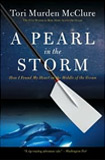Summary | Excerpt | Reading Guide | Reviews | Beyond the Book | Readalikes | Genres & Themes | Author Bio

How I Found My Heart in the Middle of the Ocean
by Tori Murden McClure
Chapter 1
The Quest Begins
June 14, 1998
latitude north 35:52, longitude west 75:34
the Outer Banks of North Carolina
In the end, I know I rowed across the Atlantic
to find my heart, but in the beginning, I wasn’t aware that it was
missing. In January 1998, I asked my uncle, "If I write a book about
my explorations, should I write it as a comedy, a history, a tragedy, or
a romance?" With a twinkle in his eye, he said, "A romance—it must
be a romance." He explained that I was too young to write my life as
a history: "Who wants to read the history of half a life?" Tragedy, he
explained, was "boring." Anyone over the age of thirty can write his
or her life as a tear-soaked muddle. "There is no challenge in that,"
my uncle counseled. "Comedies are fine, but the greatest stories in
life are about romance."
I didn’t doubt that my uncle spoke the truth, but there was a
problem. I had no experience with romance. None. I was thirty five.
Tragedy, I could write. Comedy, I could write. Even history, I
could write. Romance was out of my depth. If I had charted a map
of my life, I would have placed romance on the far side of an unexplored
ocean, where ships would drop off the edge of the world and
the legend at that edge of the map would read, "Here there be sea
monsters."
I considered myself a thoroughly modern woman. As a graduate
of Smith College, I embraced the notion that our culture had
evolved to the point where a woman might openly take on the role
of an Odysseus. Like the epic hero in Homer’s Odyssey, women
could be clever. We could set out on epic quests of our own choosing.
Like men, we could be independent and internally motivated.
Women could be tested and not found wanting in trials of courage,
resourcefulness, endurance, strength, and even solitude. What I did
not know was that exploring these vaguely masculine qualities would
not be enough for me. I am, after all, a woman. It was not until my
boat dropped off the edge of the world, into the realm of sea monsters,
that I began to understand some of what I had been missing.
Le t ’ s face it: normal , well-adjusted women don’t row alone
across oceans. According to the records of the Ocean Rowing Society,
in London, England, no woman had ever rowed solo across an
ocean, but I didn’t let this worry me. About midday on Sunday, June
14, 1998, I drove my old gray pickup truck towing a rowboat to the
Oregon Inlet Fishing Center, a few miles south of the sleepy beach
town of Nags Head, North Carolina.
I’d already made the obligatory stop at the Coast Guard station.
The officer in charge had done his best to talk me out of making
the trip. More men had walked on the moon than had successfully
rowed alone across the North Atlantic. Nonetheless, I stood squarely
behind a very simple legal precedent: men had been allowed to leave
the coast of the United States in rowboats bound for Europe. They
couldn’t very well stop me just because I was a woman. Once my boat
passed the Coast Guard inspection, I was free to go.
I backed my twenty-three-foot rowboat down a ramp and
launched the American Pearl. The boat was six feet wide at its widest
point. The tallest part of the rear cabin sat four feet above the waterline.
In the center of the vessel was a rowing deck about the size of
the cargo bed in my Ford F-150. The rowing deck was open to the
sky, but there was a watertight cabin at the back of the boat. I would
enter the cabin through a waterproof Plexiglas hatchway that was
nineteen inches square. This window-sized door between the cabin
and the rowing deck was the main hatch.
To call the stern compartment a "cabin" exaggerates the space.
The watertight sleeping area was slightly larger than a double-wide
coffin. I couldn’t sit erect without hitting my head on the ceiling, but
I could lie down with a few inches to spare. In the floor that served
as my bed there were eight small hatches. These opened into little
storage compartments that contained my electrical equipment, tools,
clothing, and other gear. Between the cabin and the rowing deck was
a cockpit that was two feet wide and sixteen inches deep. This little
footwell would serve as a kitchen, bathroom, navigational center, and
weather station. There were two small benches on either side of the
cockpit. One bench housed the desalination system that would turn
salt water into drinking water. In the other, I stored my stove and
cooking gear when they were not in use. Like my rowing station, the
cockpit was uncovered and open to the weather.
Excerpted from A Pearl in the Storm by Tori Murden McClure. Copyright © 2009 by Tori Murden McClure. Excerpted by permission of Collins, a division of HarperCollins, Inc. All rights reserved. No part of this excerpt may be reproduced or reprinted without permission in writing from the publisher.




Never doubt that a small group of thoughtful, committed people can change the world...
Click Here to find out who said this, as well as discovering other famous literary quotes!
Your guide toexceptional books
BookBrowse seeks out and recommends the best in contemporary fiction and nonfiction—books that not only engage and entertain but also deepen our understanding of ourselves and the world around us.